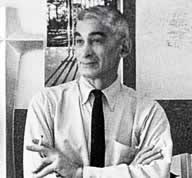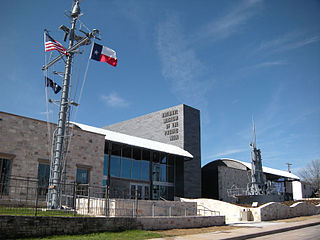
The Spanish Colonial Revival architecture, often known simply as Spanish Revival, is a term used to encompass a number of revivalist architectural styles based in both Spanish colonial architecture and Spanish architecture in general. These styles flourished throughout the Americas, especially in former Spanish colonies, from California to Argentina.
Charles Willard Moore was an American architect, educator, writer, Fellow of the American Institute of Architects, and winner of the AIA Gold Medal in 1991. He is often labeled as the father of postmodernism. His work as an educator was important to a generation of American architects who read his books or studied with him at one of the several universities where he taught.

Rice School of Architecture, also referred to as Rice Architecture, is the architecture school of Rice University in Houston, Texas. The graduate and undergraduate programs in architecture foreground design, history/theory, technology, and culture as critical academic subjects. The school maintains an enrollment of just under 200 students. Established in 1912 as the Department of Architecture with Rice University’s founding, the School of Architecture’s faculty consists of about twenty full-time architectural practitioners, historians, and theoreticians.

Caudill Rowlett Scott (CRS) was an architecture firm founded in Houston, Texas, the United States in 1946. In 1983, J.E. Sirrine, an industrial engineering firm, merged with the company and the company's name was changed to CRSS, popularly known as CRS-Sirrine. It divested itself in 1994.

Charles M. Goodman was an American architect who made a name for his modern designs in suburban Washington, D.C., after World War II. While his work has a regional feel, he ignored the colonial revival look so popular in Virginia. Goodman was quoted in the 1968 survey book Architecture in Virginia as saying that he aimed to "get away from straight historical reproduction."

The University of Illinois School of Architecture is an academic unit within the College of Fine & Applied Arts at the University of Illinois Urbana-Champaign. The school is organized around four Program Areas - Building Performance, Detail + Fabrication, Health + Well-being, and Urbanism. Faculty teach and conduct research in these areas in support of the School's primary objective to promote critical engagement with the design of a healthy and sustainable built environment.

John Fanz Staub was an American residential architect who designed numerous traditionally-styled homes and mansions, mostly in Houston, Texas from the 1920s to 1960s. He was a grandson of Peter Staub, who served as U.S. consul to St. Gallen, Switzerland.
Jeffrey Karl Ochsner is an architect, architectural historian, and professor at the University of Washington in Seattle. He is known for his research and writing on American architects Henry Hobson Richardson and Lionel H. Pries, and on Seattle architecture; he has also published articles that link architecture and psychoanalysis.
Lawrence Bradford Perkins, FAIA, MRAIC, AICP, also known as "Bradford" or "Brad Perkins,” is the founding partner of Perkins Eastman, an international architecture, interior design, urban design, planning, landscape architecture and project management firm, based in New York.
Karl Kamrath was an American architect and tennis player. He, along with Frederick James MacKie, Jr., created the Houston-based architectural firm Mackie and Kamrath. The firm's buildings reflected the principles of Organic Architecture and Usonian architecture, an outcome of Kamrath's friendship with Frank Lloyd Wright. His career spanned over five decades during which he designed residential, commercial, institutional and government buildings. Prior to founding MacKie and Kamrath, Karl Kamrath worked for Pereira and Pereira, the Interior Studios of Marshall Field and Company, and the Architectural Decorating Company in Chicago, Illinois.
William Ward Watkin was an architect primarily practicing in Houston, Texas. He was the founder of the Architecture Department of Rice University in 1912, and remained on the Rice faculty until his death. Concurrently, he also designed a number of important projects, mostly in the Houston area.
The USC School of Architecture is the architecture school at the University of Southern California. Located in Los Angeles, California, it is one of the university's twenty-two professional schools, offering both undergraduate and graduate degrees in the fields of architecture, building science, landscape architecture and heritage conservation.
John Saunders Chase Jr. was born in Annapolis, Maryland, to John Saunders Chase and Alice Viola Hall. He was an American architect who was the first licensed African American architect in the state of Texas. He was also the only Black architect licensed in the state for almost a decade. He was also the first African American to serve on the U.S. Commission of Fine Arts, which reviewed the design for the United States Vietnam Veterans Memorial.

Thomas Phifer is an American architect based in New York City.
Howard Hoppin was an American architect from Providence, Rhode Island.

Charles Burton "Chuck" Thomsen FAIA FCMAA is an American architect, construction manager, corporate executive and educator. He is the son of Fred Charles Thomsen and Sunbeam Burton Thomsen.

Elizabeth Chu Richter is a Chinese-born American architect. As of 2015, she is the 91st President of the American Institute of Architects, and has served as the Vice President of the Texas Society of Architects since 2007, representing over 85,500 AIA members. She also serves as a regional director representing Texas on the AIA's National Board of Directors.
William Wayne Caudill, FAIA was an American architect and professor. He was one of the founding partners of Caudill Rowlett Scott. The Chicago Tribune stated that he was known for his development of one of the world's largest architectural firms, introducing the team-based approach to architectural design, and building the School of Architecture at Rice University. Two years following his death, he was awarded the American Institute of Architects's gold medal.

Eugene Edwards Aubry was an American architect, based primarily in Houston, Texas and later in Orlando, Florida. He was best known for the public buildings and houses he designed and co-designed in Houston, notably the Rice Museum at Rice University and the Alfred C. Glassell School of Art at the Museum of Fine Art Houston, the Rothko Chapel, and Wortham Center. Architecture writers credit the Art Barn's industrial aesthetic with inspiring Houston's so-called "Tin House" movement, as well adaptations by Frank Gehry. Aubry was partners with two other well-known Houston architects, Howard Barnstone and S.I. Morris, and worked on projects with Philip Johnson before starting his own firm, Aubry Architects in Sarasota, Florida in 1986. He completed the Rothko Chapel after artist Mark Rothko clashed with Johnson, who was the original architect.
Preston Murdoch Geren Jr. was an American architect. A lifelong resident of Fort Worth, Texas, Geren designed or served as associate architect for many of Fort Worth's most notable buildings constructed during his working life.
























